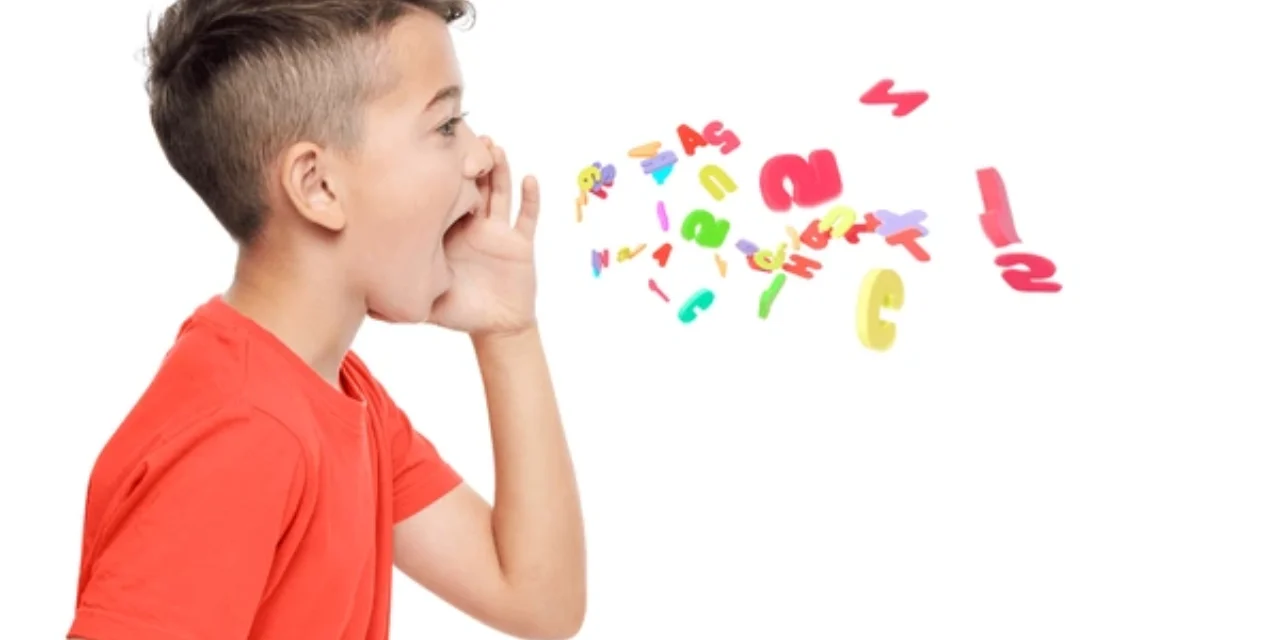Did you know that kids usually start talking around 12 to 13 months? This is when they begin symbolic play1. It’s a big step in their language journey. As parents, we can help a lot. Here are the top 5 ways to boost language skills in young kids.
Key Takeaways
- Language development is closely tied to symbolic play, starting around 12-13 months1
- Avoid pushing for complex sentences, and instead focus on short, simple phrases1
- Provide specific praise and model language to encourage toddlers’ attempts1
- Balance turn-taking and give immediate responses to emphasize communication1
- Create a language-rich environment at home through reading, songs, and daily conversations
Understanding Early Language Development Milestones
Birth to 12 Months Language Skills
Babies start showing language skills early, like coos and smiles, from 3 months2. By 10-11 months, they might say their first word and understand it2. If a baby doesn’t babble by 6 months or use gestures by 12 months, see a child health expert2.
Toddler Language Development Stages
Between 12-18 months, toddlers start saying a few words and understanding them2. Around 18 months, they use two-word sentences to talk2. By 3 years, they can speak in sentences with three or more words2. If toddlers don’t say single words by 18 months or can’t combine two words by 2 years, get advice from a child health professional2.
Key Development Indicators
Children can recognize their parents’ voices and tones from 6 months3. They start using gestures, sounds, or vocalizations to express their needs around this time3. By 15 months, they understand more than they can say, so watch their gestures and expressions3.
The Critical Role of Parent-Child Communication
Showing kids the fun of talking is key. Mimic their words and praise them for trying1. Avoid testing them too much during play, as it can be stressful. Instead, invite them to respond in a gentle way1.
Positive feedback boosts their language skills3. Playdates with peers can also help their communication3. It’s important to balance turn-taking to help them practice and engage1.
Reading and storytelling are great for language development. A rich language environment exposes them to new words and sounds, helping them understand and express themselves.
Understanding Early Language Development Milestones
Language development is a key part of a child’s growth. From birth to toddlerhood, kids hit language milestones that help them talk. Knowing these stages helps parents and caregivers support a child’s language skills.
Birth to 12 Months Language Skills
Infants start babbling and trying out sounds from birth. By 6 months, they know the sounds of their native language4. Between 8-12 months, they babble with many sounds5. This early stage is important for learning to listen and speak.
Toddler Language Development Stages
As kids get closer to 2 years old, their language gets better. Around 18 months, they start making two-word sentences5. By 24 months, they know 50 to 600 words, and their vocabulary grows fast6.
Key Development Indicators
It’s important to watch for language milestones to make sure a child is growing well. By 18-24 months, they say about 50 different words5. By 2 years old, they use 3-4 word sentences5. At 3, they speak in full sentences5. By 4-5 years, almost everyone can understand them5. Parents, teachers, and doctors help track these milestones and solve any problems.
Knowing how language develops early on is key for a child’s growth. By watching milestones and creating a language-rich environment, parents and caregivers help kids grow their language skills. This sets them up for success in life546.
The Critical Role of Parent-Child Communication

Good communication between parents and children is key for language growth. Studies show that quality talks help kids learn new words, sentence structures, and language skills7. Babies love simple, repetitive, and loud speech, while older kids need more complex words and grammar7.
It’s not how much parents talk that matters, but how well they talk. A big study found that using different words and complex sentences is more important than talking a lot7. This is seen in the “30-million-word gap,” showing how much parents from different backgrounds talk to their kids7.
- Have face-to-face talks with your child, turning off distractions and focusing on what they like7.
- Use “parentese,” a special way of speaking with exaggerated tones, to grab your child’s attention and help them learn7.
- Encourage talks back and forth, as they help predict how well babies will talk at 18 and 24 months, especially in low-income Latino families7.
- Ask wh-questions during play, as this boosts toddlers’ vocabulary and thinking in low-income African American families7.
It’s important to understand the different ways parents talk to their kids across cultures7. In African American and Hispanic families, telling stories is a big part of their talks, showing the value of cultural diversity in teaching language7.
By improving how parents and kids talk, you can help your child learn more and do well in school7. Remember, it’s the quality of these talks that counts, not how often they happen. Create a warm, language-rich space that meets your child’s needs and respects their culture7.
| Type of Parental Involvement | Impact on Children’s Language Abilities |
|---|---|
| Home-based involvement | Positive impact8 |
| School-based involvement | No significant impact8 |
| Home-school communication | Positive impact8 |
Research shows that how well parents and kids talk is more important than how much they talk, especially in low-income families7. By being responsive, engaging, and culturally aware, parents can greatly help their child’s language skills and prepare them for school7.
Reading and Storytelling for Language Enrichment
Reading aloud to children from a young age boosts their language skills and broadens their world view9. Studies show that kids grow their vocabulary and use more complex sentences with regular story exposure9. Storytelling helps them create their own stories and practice writing9.
Retelling stories lets kids revisit and refine their understanding. It helps them build characters, frameworks, and vocabulary for their own tales9.
Interactive Reading Techniques
Engage children when reading to them. Use different voices for characters and ask open-ended questions10. Babies love the sound of the human voice and face, making storytelling with expressions and gestures key for their language growth (0-1 year)10.
Toddlers enjoy interactive stories with simple, repetitive phrases. This repetition helps them predict and engage in the narrative (1-3 years)10. Preschoolers love vivid imagery, character voices, and props, which spark their imagination and improve their storytelling skills (3-5 years)10.
Picture Book Selection Tips
Picking the right picture books is crucial for your child’s language growth. Look for books with rich vocabulary and engaging illustrations. Choose themes that capture their interest9.
Encourage your child to point out objects and characters in the book. Ask them questions about the story9. Teachers who use storytelling effectively provide a powerful model for children’s oral language9.
Creating Story Time Routines
Creating a consistent story time routine is key. Set aside a special time each day in a cozy spot. Make it a moment to bond10.
For early school-age children, add questions, predictions, and moral lessons to storytelling. This promotes critical thinking and connects them to personal experiences (5-8 years)10. For older children, shared storytelling encourages creativity and confidence in storytelling (8+ years)10.
By making reading and storytelling a part of your child’s daily routine, you support their language growth and overall development910.
Daily Conversations and Language Learning

Make everyday talk a chance to grow your child’s language skills. Talk about what you do and what you see. This helps them learn lots of words and get better at speaking. Studies say reading and talking with others are for kids to learn more words and improve their language11.
Have conversations where you both share stories and thoughts. This strengthens your bond and helps your child’s language grow. Talking to yourself and your child make these conversations more interesting and helpful for learning11.
Use daily moments like eating and driving to teach new words. By talking about what you’re doing, you help your child learn more. The more they hear and use language, the better they’ll get at talking.
“The key to language development is exposure – the more your child hears and interacts with language, the more they will learn.”
Try dialogic reading11 and talk about books you read together. This way, you not only teach new words but also improve their language skills. It’s a great way to help them succeed in the long run.
Language learning is a journey. By using everyday language, conversational skills, and vocabulary building in your daily life, you’ll help your child become a confident speaker. Daily talks can unlock your child’s full language potential11.
The Power of Music and Songs in Language Development
Music and language are closely linked, with studies showing music’s big impact on a child’s language skills12. Babies start with billions of brain cells, which connect as they grow12. Kids who listen to music early on develop strong connections that boost their language abilities12.
Nursery Rhymes Benefits
Music and language are closely tied, as kids can mimic the rhythm of their native tongue before speaking words12. Singing in a second language helps bilingual kids practice sounds and understand through repetition12. Music exposes bilingual babies to different sounds, improving their communication and listening12.
Musical Activities for Language Growth
Music play introduces kids to speech elements like intonation and rhythm, enhancing their language skills13. Singing and dancing with a baby teaches them about rhythm, key for speaking13. Parent-child music classes that include singing, dancing, and playing instruments boost language development in kids13.
Music play is a key tool for language development in young children’s first 1000 days, shaping their skills in many areas13.
The role of music and songs in language development is undeniable. From nursery rhymes to musical activities, music enriches a child’s language growth121413.
Creating a Language-Rich Environment at Home
Creating a language-rich environment at home is key for your child’s speech growth. By adding language learning to daily play, you help their home learning. This sets the stage for their speech development15.
Begin by naming objects in your child’s world and talking about them. This boosts their vocabulary and encourages them to explore15. Also, try to add more to what they say, making their language more complex15.
Have interactive reading times where you and your child dive into the story together15. Use family meals to talk and grow their language skills16.
| Strategies for a Language-Rich Home | Benefits |
|---|---|
| Label objects and discuss their properties | Expands vocabulary, encourages engagement |
| Expand on your child’s words | Adds complexity to their language |
| Engage in interactive reading sessions | Fosters participation and language growth |
| Enjoy shared mealtimes with meaningful conversations | Enhances language development |
By using these methods, you can make a language-rich environment at home. This supports your child’s home learning and boosts their speech development. Use everyday moments to help your child grow linguistically1516.
The Impact of Interactive Play on Speech Development
Interactive play is a great way to improve language skills in young kids. Studies show that structured play helps a lot with learning new words in early childhood. It shows a big impact on how well kids talk17.
Play helps kids learn many words and talk with others. This makes their speech skills grow in big ways.
Role-Playing Activities
Role-playing games let kids use their language skills in fun, creative ways. They act out different roles and stories. This helps them practice speaking and listening18.
It’s not just about language. It also boosts creativity, problem-solving, and social skills.
Language-Building Games
- Games like “I Spy” and “Rhyming Pairs” help kids learn new words and sounds.
- Board and card games teach kids to follow directions and talk with others.
- Games that need sharing and taking turns help kids practice talking in a group setting.
Playing language-focused games can really help a child’s speech skills17. These games introduce new words and encourage kids to use language in real ways. They also help kids talk with their friends.
| Activity | Language Skills Targeted | Age Range |
|---|---|---|
| Storytelling with props | Narrative skills, vocabulary, sentence structure | 3-6 years |
| Matching games | Categorization, vocabulary, following instructions | 2-5 years |
| Cooperative board games | Turn-taking, social interaction, communication | 4-8 years |
Adding interactive play to a child’s day can really help their speech17. By making playtime language-rich, parents and caregivers help kids learn to talk better. This supports their language skills and communication.
“Play provides an environment where children frequently use language, and interventions aimed at enhancing communication skills during play have shown improvements in toddlers with language delays.”18
Using Gestures and Non-Verbal Communication
Gestures and body language are key in a child’s language growth. Research shows that positive nonverbal cues can make a child feel loved and help them learn life skills19. Having a warm relationship with a child is vital, and using positive body language helps a lot19.
Nonverbal signals can make verbal messages clearer, helping to build stronger bonds19.
Gestures and body language are understood everywhere, no matter the culture or language20. Babies start using gestures before they say their first words20. These gestures help shape how they think, communicate, and understand language20.
Using positive body language, like touching and making eye contact, shows a child you care19. Playing games together can also improve how well family members communicate without words19. This is especially true for kids with autism or other special needs, who might use gestures or pictures more19.
By adding gestures and non-verbal cues to your talks with kids, you can boost their language skills. You’ll also strengthen your bond and better understand their needs1920.
Building Vocabulary Through Daily Activities
Learning new words is key for young kids, and it’s not just for school. Parents can use daily life to help kids learn new words in fun ways.
Mealtime Language Opportunities
Mealtimes are great for learning new words. While cooking and eating, talk about the food, utensils, and how things are made. Point out the colors, shapes, and cooking steps.21 This way, kids learn new words and get to talk more.
Outdoor Learning Experiences
Going outside is full of chances to learn new words. At the park, on a nature walk, or in the backyard, name the plants, animals, and things you see.21 Ask your child questions and listen to their thoughts. This helps them become curious about the world22.
For kids to learn words well, they need to hear them often and in fun ways. Make learning a part of your daily life to help your child grow strong in language and communication.21
The Role of Repetition and Consistency
Teaching young children new words and phrases is just the start. Consistent communication and repetition are key to making these new ideas stick23.
Studies show that repeating sentences helps spot language issues in kids23. But, it’s not the only thing that matters. Skills like remembering sounds and understanding language are more important23.
Research also finds that hearing words often helps kids learn new vocabulary24. When kids hear words a few times, their brains quickly start to remember them24. This shows how well they can recall these words later24.
Creating routines that repeat language is vital for learning. Activities like reading aloud, finishing stories, and dictations are great. They’re easy and quick, helping kids feel more confident and skilled23.
“Repetition is the key to language learning. Consistent use of words and phrases helps children grasp new concepts and build their communication skills.”
By making repetition a part of your child’s day, you create a language-rich environment2324.
Positive Reinforcement and Language Growth
Positive feedback and encouragement are key for a child’s language growth25. Teachers who use positive reinforcement focus on what children do well25. They highlight their efforts, skills, and attitudes25. Giving specific feedback, not just general praise, helps improve language skills25.
Reminders are also important for language confidence25. They help students stay organized and on task25. Teachers should remind students early to avoid frustration25. Redirecting language helps guide children when they lose focus, with clear instructions being best25.
Visualizing success can also increase a child’s language confidence25. It helps them see their goals and believe in themselves25. Teachers must believe in the positive identities they give students for it to work25. Avoiding negative names helps keep the learning space positive25.
| Characteristic | Description | Impact on Language Development |
|---|---|---|
| Positive Reinforcement | Focusing on a child’s strengths and positive efforts | Enhances language skills, boosts confidence, and creates an inclusive environment |
| Reminders | Using language to keep children organized, responsible, and on track | Prevents frustration, supports self-control, and guides children back on task |
| Envisioning Language | Helping children visualize success and set positive goals | Builds confidence, reinforces positive identities, and maintains a constructive learning environment |
By using these positive techniques, parents and teachers can create a supportive environment for language growth26.
Screen Time and Language Development
As parents, we face a big challenge. We must balance technology use with our children’s growth. The effect of screen time on language skills is complex. Learn how to make smart choices about your child’s digital.
Educational Apps and Programs
Some apps and programs can help with language learning. But, it’s important to know their limits. Kids start to understand screens better after age two, thanks to screen time27.
But not all screen time is the same. Good, age-right content like “Sesame Street” and “Bluey” can help with talking, colors, numbers, and life lessons27.
Setting Healthy Digital Boundaries
Setting good digital limits is crucial. The World Health Organization and the American Academy of Pediatrics say kids should watch screens for only one hour a day from age 2 to 5. This helps them stay active and social, which is very important27.
Also, watching your child’s screen time and joining in can really help with language skills28.
Too much screen time, especially bad content, can hurt language skills27. By finding a balance and making sure your child talks a lot, you can use technology to help their language grow.
Every child is different, and dealing with screen time and language needs careful thought. Stay up to date, think about what’s best for your child, and ask for help from experts if you need to. With the right steps, your child’s language skills can do well in today’s digital world282927.
Social Interactions and Peer Learning
Language growth in young kids isn’t just about talking to parents. Friends and social learning are key in shaping their language skills30. Research shows that friendships are crucial for kids with Developmental Language Disorder (DLD). They help in building friendships and improving social skills30.
Children with DLD often struggle to make friends and feel left out30. This can lead to mental health issues30.
Creating a world where your child can learn through social experiences is powerful. Playdates and group activities can spark language growth3031. These moments help kids learn to share, listen, and express feelings31.
Here are some tips for planning social activities:
- Choose games and activities that are fun and language-focused.
- Encourage your child to talk to others, ask questions, and make requests.
- Show them how to act and speak in social situations by being a good example.
- Always praise your child when they use their language and social skills well.
By focusing on social interactions, you help your child grow in language and social skills3031.
Creating a world where your child can explore and learn from others is a great investment3031.
Addressing Common Language Development Concerns
Children grow at different rates, and their language skills are no exception. Knowing common concerns can help parents spot issues early. Understanding speech and language milestones by age is key to recognizing when a child might need help32.
Developmental milestones vary widely, and cultural background and language exposure play big roles. About 1 in 68 kids have autism, which can impact communication. Yet, many language delays can be treated, leading to better school and social life32.
- By 12 months, if a child is not using gestures like pointing or waving bye-bye, they should be assessed33.
- By 18 months, if a child prefers using gestures over vocalizations to communicate, they should be monitored33.
- By 2 years, if a child is only imitating speech or actions, and not producing words or phrases spontaneously, they may have a speech delay33.
- By 2 years, if a child is saying only some sounds or words repeatedly and not using oral language to communicate more than their immediate needs, they may have a speech delay33.
- By 2 years, if a child is not able to follow simple directions, they should be examined33.
Parents and caregivers should understand that by 2 years, they should get about 50% of a child’s speech. By 3 years, this should increase to 75%. By 4 years, most people should understand a child’s speech, even if they don’t know them33.
If you worry about your child’s language development, talk to your pediatrician or a speech-language pathologist. They can evaluate your child and suggest the right help32. With the right support, children with language delays can make great strides and succeed32.
| Developmental Milestone | Age Range | Potential Concern |
|---|---|---|
| Using gestures (pointing, waving bye-bye) | 12 months | If not using gestures, child should be assessed |
| Preferring gestures over vocalizations | 18 months | Child should be monitored |
| Imitating speech/actions, not producing words/phrases | 2 years | May indicate a speech delay |
| Saying only some sounds/words repeatedly | 2 years | May indicate a speech delay |
| Unable to follow simple directions | 2 years | Child should be examined |
“Timely intervention is crucial; speech and language delays are treatable, leading to better academic and social outcomes.”
Conclusion
Nurturing language development in young children is key for their growth. By using different strategies, parents can help kids express themselves and connect with others. This sets them up for success in school and life34.
Children go through different stages of language growth from birth to five years old. Caregivers are crucial in helping them. They do this by reading, telling stories, and talking with kids. This helps kids improve their communication skills34.
Speech therapy is also important for kids who might be slow to talk. It helps them catch up and communicate better34.
By focusing on language, parents give their kids a strong start in school. Through fun and positive interactions, families can foster a love for language. This helps kids grow and explore the world around them35.
FAQ
What are some expert-backed strategies to boost my child’s language skills?
What are the crucial language milestones from birth to age three?
How can I engage in face-to-face interactions to support my child’s language development?
What are the benefits of reading to my child, and how can I make it engaging?
How can I incorporate language learning into everyday routines?
How can music and songs support language development?
What strategies can I use to create a language-rich home environment?
How can interactive play boost my child’s language skills?
How can I incorporate non-verbal communication in language development?
How can I use everyday activities to build my child’s vocabulary?
Why is repetition important in language learning, and how can I incorporate it?
How can positive reinforcement impact my child’s language development?
How can I balance screen time and real-life interactions to support language development?
How do social interactions impact language development, and how can I facilitate them?
When should I seek professional help for language development concerns?
Source Links
- Helping Toddlers Expand Language Skills – Child Mind Institute
- Language development in children: 0-8 years
- 17 Ways to Promote Language Development in Children
- Speech and Language Developmental Milestones
- Understanding language development milestones
- Language Development Domain – Child Development (CA Dept of Education)
- Parent-Child Interactions Support Early Language Development in Diverse Families – The International Congress of Infant Studies
- Understanding the impact of parental involvement subtypes on Chinese preschool children’s language ability
- Developing Language Skills Through Storytelling
- 4 ways to boost children’s language development | Famly
- Music development in Early Childhood | Bilingual education
- The Power of Music Play: Enhancing Language Development in Early Childhood
- Music and early language development | Famly
- 10 Easy Ways to Cultivate a Language Rich Environment in Your Home
- The Impact of Structured Play on Language Acquisition in Early Childhood – Kids Kingdom Early Learning Center
- Is there a Correlation Between Language Development and Levels of Play?
- Nonverbal communication: body language and tone of voice
- Frontiers | The Role of Gesture in Communication and Cognition: Implications for Understanding and Treating Neurogenic Communication Disorders
- Teaching Vocabulary
- 4 Vocabulary Development Activities for Families at All Ages
- Sentence repetition is a measure of children’s language skills rather than working memory limitations
- Repetition a key factor in language learning
- Teacher Language: Reinforcing, Reminding, Redirecting, and Envisioning
- Reinforcing Language Skills for Our Youngest Learners
- Screen Time and Speech Delays in Toddlers
- The influence of screen time on children’s language development: A scoping review
- Mobile device screen time is associated with poorer language development among toddlers: results from a large-scale survey – BMC Public Health
- Reviewing the link between language abilities and peer relations in children with developmental language disorder: The importance of children’s own perspectives
- What is the nature of peer interactions in children with language disorders? A qualitative study of parent and practitioner views
- How to Raise Concerns about a Child’s Speech and Language Development: Do’s and Don’ts
- Delayed Speech or Language Development (for Parents)
- Physio Inq
- The Link Between Language and Literacy





